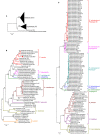Complete Genome Sequence of 3-Chlorobenzoate-Degrading Bacterium Cupriavidus necator NH9 and Reclassification of the Strains of the Genera Cupriavidus and Ralstonia Based on Phylogenetic and Whole-Genome Sequence Analyses
- PMID: 30809202
- PMCID: PMC6379261
- DOI: 10.3389/fmicb.2019.00133
Complete Genome Sequence of 3-Chlorobenzoate-Degrading Bacterium Cupriavidus necator NH9 and Reclassification of the Strains of the Genera Cupriavidus and Ralstonia Based on Phylogenetic and Whole-Genome Sequence Analyses
Abstract
Cupriavidus necator NH9, a 3-chlorobenzoate (3-CB)-degrading bacterium, was isolated from soil in Japan. In this study, the complete genome sequence of NH9 was obtained via PacBio long-read sequencing to better understand the genetic components contributing to the strain's ability to degrade aromatic compounds, including 3-CB. The genome of NH9 comprised two circular chromosomes (4.3 and 3.4 Mb) and two circular plasmids (427 and 77 kb) containing 7,290 coding sequences, 15 rRNA and 68 tRNA genes. Kyoto Encyclopedia of Genes and Genomes pathway analysis of the protein-coding sequences in NH9 revealed a capacity to completely degrade benzoate, 2-, 3-, or 4-hydroxybenzoate, 2,3-, 2,5-, or 3,4-dihydroxybenzoate, benzoylformate, and benzonitrile. To validate the identification of NH9, phylogenetic analyses (16S rRNA sequence-based tree and multilocus sequence analysis) and whole-genome sequence analyses (average nucleotide identity, percentage of conserved proteins, and tetra-nucleotide analyses) were performed, confirming that NH9 is a C. necator strain. Over the course of our investigation, we noticed inconsistencies in the classification of several strains that were supposed to belong to the two closely-related genera Cupriavidus and Ralstonia. As a result of whole-genome sequence analysis of 46 Cupriavidus strains and 104 Ralstonia strains, we propose that the taxonomic classification of 41 of the 150 strains should be changed. Our results provide a clear delineation of the two genera based on genome sequences, thus allowing taxonomic identification of strains belonging to these two genera.
Keywords: ANI (average nucleotide identity); Cupriavidus; Ralstonia; TNA (tetra-nucleotide analysis); aromatic degradation; reclassification.
Figures









Comment in
-
Commentary: Complete Genome Sequence of 3-Chlorobenzoate-Degrading Bacterium Cupriavidus necator NH9 and Reclassification of the Strains of the Genera Cupriavidus and Ralstonia Based on Phylogenetic and Whole-Genome Sequence Analyses.Front Microbiol. 2019 Aug 28;10:2011. doi: 10.3389/fmicb.2019.02011. eCollection 2019. Front Microbiol. 2019. PMID: 31555242 Free PMC article. No abstract available.
Similar articles
-
Commentary: Complete Genome Sequence of 3-Chlorobenzoate-Degrading Bacterium Cupriavidus necator NH9 and Reclassification of the Strains of the Genera Cupriavidus and Ralstonia Based on Phylogenetic and Whole-Genome Sequence Analyses.Front Microbiol. 2019 Aug 28;10:2011. doi: 10.3389/fmicb.2019.02011. eCollection 2019. Front Microbiol. 2019. PMID: 31555242 Free PMC article. No abstract available.
-
The chlorocatechol-catabolic transposon Tn5707 of Alcaligenes eutrophus NH9, carrying a gene cluster highly homologous to that in the 1,2,4-trichlorobenzene-degrading bacterium Pseudomonas sp. strain P51, confers the ability to grow on 3-chlorobenzoate.Appl Environ Microbiol. 1999 Feb;65(2):724-31. doi: 10.1128/AEM.65.2.724-731.1999. Appl Environ Microbiol. 1999. PMID: 9925607 Free PMC article.
-
Transcriptome differences between Cupriavidus necator NH9 grown with 3-chlorobenzoate and that grown with benzoate.Biosci Biotechnol Biochem. 2021 May 25;85(6):1546-1561. doi: 10.1093/bbb/zbab044. Biosci Biotechnol Biochem. 2021. PMID: 33720310
-
The complete multipartite genome sequence of Cupriavidus necator JMP134, a versatile pollutant degrader.PLoS One. 2010 Mar 22;5(3):e9729. doi: 10.1371/journal.pone.0009729. PLoS One. 2010. PMID: 20339589 Free PMC article.
-
Metabolic reconstruction of aromatic compounds degradation from the genome of the amazing pollutant-degrading bacterium Cupriavidus necator JMP134.FEMS Microbiol Rev. 2008 Aug;32(5):736-94. doi: 10.1111/j.1574-6976.2008.00122.x. Epub 2008 Aug 7. FEMS Microbiol Rev. 2008. PMID: 18691224 Review.
Cited by
-
Commentary: Complete Genome Sequence of 3-Chlorobenzoate-Degrading Bacterium Cupriavidus necator NH9 and Reclassification of the Strains of the Genera Cupriavidus and Ralstonia Based on Phylogenetic and Whole-Genome Sequence Analyses.Front Microbiol. 2019 Aug 28;10:2011. doi: 10.3389/fmicb.2019.02011. eCollection 2019. Front Microbiol. 2019. PMID: 31555242 Free PMC article. No abstract available.
-
Genomic characterization of denitrifying methylotrophic Pseudomonas aeruginosa strain AAK/M5 isolated from municipal solid waste landfill soil.World J Microbiol Biotechnol. 2022 Jun 16;38(8):140. doi: 10.1007/s11274-022-03311-7. World J Microbiol Biotechnol. 2022. PMID: 35705700
-
Whole genome sequence analysis of Cupriavidus campinensis S14E4C, a heavy metal resistant bacterium.Mol Biol Rep. 2020 May;47(5):3973-3985. doi: 10.1007/s11033-020-05490-8. Epub 2020 May 13. Mol Biol Rep. 2020. PMID: 32406019 Free PMC article.
-
Isolation and Genomic Analysis of 3-Chlorobenzoate-Degrading Bacteria from Soil.Microorganisms. 2023 Jun 28;11(7):1684. doi: 10.3390/microorganisms11071684. Microorganisms. 2023. PMID: 37512857 Free PMC article.
-
Genomic, morphological, and biochemical analyses of a multi-metal resistant but multi-drug susceptible strain of Bordetella petrii from hospital soil.Sci Rep. 2022 May 19;12(1):8439. doi: 10.1038/s41598-022-12435-7. Sci Rep. 2022. PMID: 35589928 Free PMC article.
References
LinkOut - more resources
Full Text Sources
Molecular Biology Databases
Research Materials
Miscellaneous

